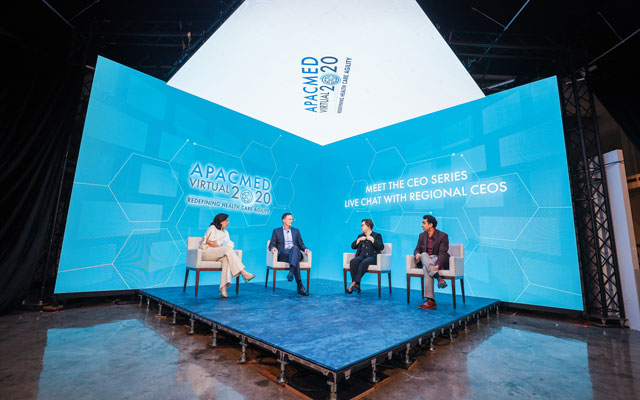Organisers of the APACMed Virtual Forum successfully pulled off one of the first hybrid meetings to take place in Singapore where 50 on-site delegates were joined by a larger number online.
Hot idea
Consider a hybrid event for on-site delegates to network in-person if the situation and country allows for it, as opposed to an entirely virtual endeavour

Brief
The APACMed (Asia Pacific Medical Technology Association) Virtual Forum was designed to cover topics from innovative technological advancements in the healthcare industry to the larger impact of US-China relations on the entire medical supply chain.
This year’s event echoed APACMed’s objective of obtaining greater engagement each successive year, with not just healthcare professionals and industry representatives, but also a large number of government representatives and start-ups; and meet its target focus to share learnings and to grow as a community to achieve its mission to continuously improve standards of care for patients, and to jointly shape the future of healthcare in Asia-Pacific.
Highlights
The event featured five global CEO keynotes, as well as 50 conference sessions (of which 20 per cent were about digital health solutions). Over 75 trade associations and industry regional leaders also shared their leadership journeys.
According to Maryline Marquet, vice president, operations Asia-Pacific, APACMed, most countries wanted to share their opinions and insights to pave a common working path forward, with this year’s virtual road trip on digital innovations showing what the industry will continue to see moving forward, be it AR, 3D, digital therapeutics, remote monitoring or telehealth.
Challenges
This was not only an unprecedented event for APACMed but the industry as a whole. This meant that APACMed had to learn on the job, as it was the forerunner to attempt a full-day hybrid conference.
Marquet elaborated: “We had a whole new set of requirements due to the virtual aspect of the conference. Even though all of us have used Zoom for months, when you have people connecting from around the world at the same time, panellists who have never met and who need to build a rapport virtually, you need to prepare relentlessly.
“Everything needs to be rehearsed, briefed technically, and tested comprehensively. In short 130 speakers meant 130 briefs, which mean 130 connections, and if the sound disappears or any technical glitches occur, you have to be prepared to activate Plan B to ensure the audience doesn’t disengage.”
Plan B meant that APACMed had half of its content pre-recorded in case of any technical errors in the live sessions. If anything went wrong, the pre-record session would be played across multiple tracks.
Marquest shared that one of the live roundtable sessions ended up going on for much, much longer than the delegated time because of the engaging conversation.
She added: “But we couldn’t get them to stop since it was a virtual event and we didn’t want to interrupt the active discussion.”
Marquest further revealed that participation was maintained throughout the day, with attendees staying online from 09.00 to 17.00.
The key takeaway, Marquet commented, is that a virtual conference is beyond any doubt a worthy alternative in the current climate and probably the future.
“The entire morning was attended by over 90 per cent of registered participants and as the content continues to be available for 30 days post-event, we continue to see daily viewers on the platform,” she shared.
It shows the eagerness in people to take time and digest the information shared, she pointed out.
Event APACMed Virtual Forum
Organiser Asia Pacific Medical Technology Association (APACMed)
Date September 24, 2020
Attendance 1,450 attendees from 34 countries, organised in Singapore as a hybrid event with 50 studio attendees





















